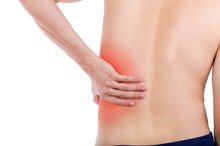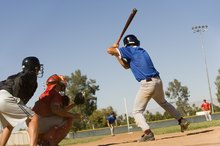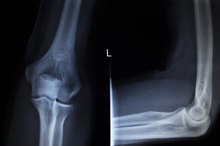Lower Back Pain and Skateboarding
Your back is especially vulnerable to injury while skateboarding because it absorbs much of the impact during falls and landings, and it is also involved in maintaining balance and twisting motions. Lower back pain can stem from different types of injuries and can be prevented by strengthening exercises and stretching.
If you are experiencing serious medical symptoms, seek emergency treatment immediately.
Muscle Strains
One cause of lower back pain in skateboarders is muscle strains 1. Like all of the muscles in the body, sudden movements can injure back muscles. Your posture during the basic forward movement which involves bending your trunk and upper legs into a V shape may put strain on your lower back. Poor posture and overuse can also cause muscle injury, causing the muscles to spasm and be painful when used. Muscle sprains are classified as grade 1, 2 or 3, depending on the severity of the injury. Grade 1 tears cause mild discomfort, whereas grade 3 sprains can make walking difficult and can cause severe pain and swelling around the injured muscle, according to Sportsinjuryclinic.net.
- One cause of lower back pain in skateboarders is muscle strains 1.
- Your posture during the basic forward movement which involves bending your trunk and upper legs into a V shape may put strain on your lower back.
Spine Injuries
My Lower Back Always Hurts After Basketball
Learn More
Lower back pain can also stem from problems affecting the spine itself. Skateboarders often land hard on their feet or buttocks and the impact is transmitted through the spine. Spondylolisthesis, also known as slipped vertebrae, can cause progressively worsening back pain. Impact injuries can also damage the vertebra and vertebral discs, which will also cause lower back pain in skateboarders.
- Lower back pain can also stem from problems affecting the spine itself.
- Impact injuries can also damage the vertebra and vertebral discs, which will also cause lower back pain in skateboarders.
Treatment
Lower back pain can be treated with rest, ice, compression and elevation, sometimes referred to as RICE. A back brace or crutches might help provide extra support for your back. If the pain is severe or gets worse over time, you might need to see a back specialist to ensure that your spinal cord is not injured. A licensed back specialist can also prescribe medications, specific exercises or massage to relieve your pain.
- Lower back pain can be treated with rest, ice, compression and elevation, sometimes referred to as RICE.
- A licensed back specialist can also prescribe medications, specific exercises or massage to relieve your pain.
Prevention
What Are the Causes of Pain in the Left Lower Back?
Learn More
Aside from avoiding hard landings and sudden movements, skateboarders can prevent back pain by keeping their backs strong. Back exercises will help provide extra support for the spine and reduce the risk of injury. A partial situp, in which you only lift your shoulders and head slightly off the floor, will improve your back's strength. Other recommended exercises include lying on your back and pulling your knees to your chest, and pelvic lifts.
- Aside from avoiding hard landings and sudden movements, skateboarders can prevent back pain by keeping their backs strong.
- A partial situp, in which you only lift your shoulders and head slightly off the floor, will improve your back's strength.
Related Articles
References
- Sports Injury Clinic: Back Muscle Strains
- Spine-Health: Potential Causes of Back Pain in Children and Teens
- Scherl SA. Adolescent idiopathic scoliosis: Clinical features, evaluation, and diagnosis. UpToDate. Updated November 22, 2019.
- National Institute of Neurological Disorders and Stroke. Low Back Pain Fact Sheet. Updated August 13, 2019.
- American Academy of Orthopedic Surgeons. Low Back Pain.
- Biyani A, Andersson GB. Low back pain: pathophysiology and management. J Am Acad Orthop Surg. 2004;12(2):106-115.
- Goel A. Is it necessary to resect osteophytes in degenerative spondylotic myelopathy? J Craniovertebr Junction Spine. 2013;4(1):1-2. doi:10.4103/0974-8237.121615
- National Institute of Arthritis and Musculoskeletal and Skin Diseases. Spinal Stenosis. Updated August 2016.
- American Academy of Orthopaedic Surgeons. Spondylolysis and Spondylolisthesis. 2016.
- Scherl SA. Adolescent idiopathic scoliosis: Clinical features, evaluation, and diagnosis. Updated November 22, 2019.
- Casazza BA. Diagnosis and Treatment of Acute Low Back Pain. Am Fam Physician. 2012;85(4):343-350.
- National Center for Complementary and Integrative Health. Mind and Body Approaches for Chronic Pain: What the Science Says. 2019.
Writer Bio
Adam Cloe has been published in various scientific journals, including the "Journal of Biochemistry." He is currently a pathology resident at the University of Chicago. Cloe holds a Bachelor of Arts in biochemistry from Boston University, a M.D. from the University of Chicago and a Ph.D. in pathology from the University of Chicago.









